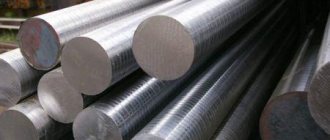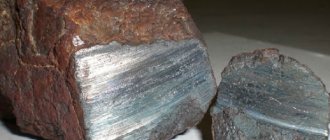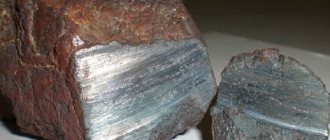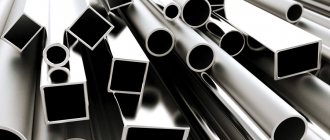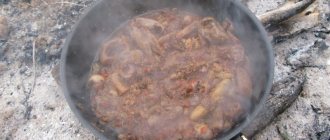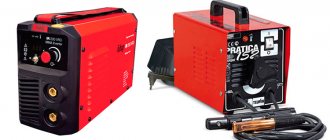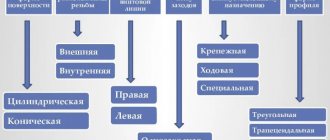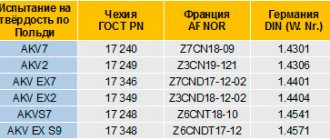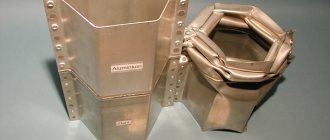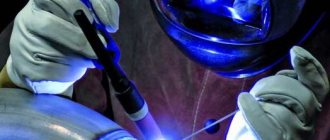History of the creation of stainless steel
Harry Brearley is credited with creating corrosion-resistant steel. In 1913, he was engaged in research into steel alloys needed for the manufacture of gun barrels. The self-taught metallurgist acted according to a trial and error system. He added various additives to the alloy and tested the strength of the resulting samples. He threw unsuccessful specimens into the corner, where the blanks rusted.
His attention was drawn to a small ingot that was taken out of the furnace a month ago: it was not rusty and looked like new. The alloy was 85% iron. Also included:
- silicon;
- manganese;
- carbon;
- chromium.
This was the first example of stainless steel.
Modern stainless steel details. In 1915, an English company from the city of Sheffield announced the creation of a new alloy with an excellent appearance: it is not susceptible to corrosion and is resistant to abrasion.
Pros and cons of a stainless steel knife
There are different types of knives. In the kitchen there are knives for meat, vegetables, and bread. A good cutting tool should have a perfectly straight cutting edge. Cracks or chips indicate that the quality of the material is very low. This knife won't last long.
Blades made of carbon steel have a sharp edge and are easy to sharpen. But over time they rust and become unusable.
High carbon steel combines the advantages of carbon steel and stainless steel. Sharpness and corrosion resistance are the main properties.
Advantages
Stainless steel is the leading choice in the production of knives. Often, components are added to the material to improve the quality of the product. These are chromium, manganese, molybdenum, vanadium. Chrome makes a steel knife resist rust. It also gives additional strength. Advantages of such knives:
- Even with prolonged contact with water and high humidity, the knives do not rust.
- They are hard and do not break when dropped or hit hard.
- Resistant to temperature changes, withstands high and low temperatures.
- No foreign tastes are left on the product.
- They delight you with a pleasant view. They shine, and with prolonged use they do not lose quality.
Stainless steel knife.
Flaws
The main disadvantage is that a stainless steel knife becomes dull quickly. Frequent sharpening leads to a decrease in the thickness of the material. You should also remember that there are no self-sharpening knives. Any knife, no matter what material it is made from, loses its sharpness after a certain period of time.
Peculiarities
The corrosion resistance of steel is ensured by an ultra-thin, chromium-rich oxide film. The thickness is very small (about 2 nanometers, or 0.002 microns), so the film is transparent. But it serves to protect the alloy from the effects of the environment.
The film appears after passivation - adding chromium to the alloy. The content of this element is increased to 12%, then the alloy is recognized as stainless.
Stainless knives made only from martensitic steels
Martensite knives have the required level of hardness. Of all the types of alloys, this is the most preferred for making knives.
Effect of carbon content on martensite hardness
The hardness of martensite without tempering depends on how much carbon the alloy contains. The higher the percentage of the latter, the harder the material. This is clearly seen from the table.
Hardness of martensite.
Heat treatment
The heat treatment of martensitic steels is not much different from the heat treatment of conventional carbon steels and includes three stages: austenitization (heating for hardening), quenching and tempering.
The heat treatment time for martensitic stainless steels is much shorter. The first reason: steel contains carbides. Their dissolution in austenite is slowed down due to the fact that the composition contains chromium molecules. The second reason: the thermal conductivity of stainless steel is lower than that of ordinary carbon steel.
Carbides
Due to the increased carbon content of martensitic stainless steels, corrosion resistance is lower. This is because high carbon content reduces the amount of chromium that can dissolve in austenite.
Carbide particles (Cr, Fe)23C6 reduce the chromium content (as is known, 12% is needed for corrosion resistance), which makes the metal susceptible to corrosion.
Martensitic transformation
Martensitic steel undergoes a martensitic transformation process. This is a process of polymorphism, which is characterized by a change in the position of atoms or molecules in a crystal relative to each other. Martensitic transformation can be called the process of deformation of the crystal lattice. As a result of martensitic transformation, it is possible to change the characteristics and properties of metals. This is achieved most often by heat treatment. It is also possible to change the characteristics by mechanical processing.
Varieties
Stainless steels are divided into several types:
- ferritic;
- martensitic;
- austenitic.
Several types of stainless steel are used for knives.
Martensitic
Materials with a martensitic structure lend themselves well to hardening. These steels include grades 65Х13, 95Х18, 440С. They have a high degree of hardening compared to simple carbon alloys (1050-1100 versus 750-800), but their hardness is one or two Rockwell units lower. This is due to the fact that chromium has a binding effect on carbon, which reduces the hardening structure of martensite. This gave rise to the name.
Ferritic
The ferrite structure is soft and cannot be hardened. The corrosion resistance of this material is a solid C on a five-point scale. This includes brands 04Х13, 02Х18.
Austenitic or chromium-nickel steels
Austenitic stainless steels are steel grades: X12N8, X12N8T10. The material can be hardened, but at the same time the viscosity increases and the hardness decreases.
Main advantages:
- High corrosion resistance prevents rust from water, acids, and dirt.
- Does not fade over time.
- It has monstrous viscosity and plasticity. When the tensile load is applied, the wire elongates 16 times. Even brass and copper do not have this property. After deformation, it freely returns to its previous shape.
- During cold forging, the material is capable of strongly hardening (up to 45 Rockwell units) while maintaining viscosity.
Ferritic-austenitic or two-phase alloy
There is a separate group: ferritic-austenitic, otherwise such samples are called duplex or two-phase steels. Duplexes are approximately half ferrite and half austenite and have characteristics of both phases. To obtain such an alloy, in addition to chromium and nickel, molybdenum and vanadium are added to the mix. This is necessary to increase tensile strength and facilitate the welding process.
Knife made of two-phase alloy.
A very important indicator of duplexes is their unique strength. Due to its low price, as well as ease and flexibility in processing, it is successfully used in many industries.
Precipitation hardening stainless steels
These steels are also called high-strength stainless steels. Precipitation hardening stainless steels contain aluminum, niobium or tantalum and obtain their properties through quenching, strain hardening, age hardening and martensitic transformation. The steel is first heated and hardened to transform austenite into martensite. Reheating causes the precipitation of strengthening particles such as NiAl3 from the martensite. The high strength of these steels is achieved even with low carbon content.
Dispersion-hardening steels include steels 07Х16Н6, 09Х15Н8У, 08Х17Н5М3, 04Х25Н5М2, ХН40МДТУ according to GOST 5632-72.
Popular steels for stainless knives
High-quality knives are made from certain grades of steel. The carbon and chromium content in popular knife steels is shown in the table:
Carbon and chromium content in knife steels.
Choosing a steel grade for stainless knives
Four types from the list were considered optimal. First of all:
- 12C27 from Sandvik;
- AEB-L from Uddeholm;
- DD400 from Minebea;
- AUS6.
They best combine the properties necessary for a knife blade.
Aisi 304
AISI contains 18% Cr and 8% Ni. In this ratio, chromium and nickel form an oxide layer on the surface that is resistant to chemicals. This is the main advantage of the material used in the production of knives. AISI is the most popular brand in the stainless steel category. Due to its versatility, it is in high demand and is used everywhere.
Applicability:
- chemical and pharmaceutical industry;
- production of surgical equipment, injection needles;
- shipbuilding (production of fasteners for nuclear ships);
- rolled metal;
- oil and mining industry;
- production of equipment designed to work with chemical exposure.
12Х18Н10Т
Chromium-nickel-titanium steel from the austenite class 12Х18Н10Т has found widespread use due to its ability to work in different conditions. High corrosion resistance in some liquid media is its main advantage. It is highly plastic and can be used in deep cold conditions. Due to this property, steel is used in plants for producing liquid oxygen.
Steel 1.4034 (X46Cr13)
The alloyed material belongs to martensites; the high-strength and corrosion-resistant alloy contains additional components that make its properties even more unique. The alloy contains 0.46% carbon, which gives excellent strength. Chrome creates anti-corrosion properties and has a positive effect on wear resistance. Its quantitative composition lies in the range of 12.5–14.5%.
Knives made of X46Cr13 have an optimal hardness of 53–56 Hrc on the Rockwell scale. Positive traits:
- holds an edge well;
- do not change color;
- do not undergo oxidation;
- have a respectable appearance throughout their entire service life.
Ideal for intensive use.
Lohmann lo r4528
Lohmann lo r4528 stainless steel is a martensitic corrosion-resistant steel. The material is able to perfectly maintain the sharpness of the cutting surface. Its hardness is 58-60 HRC. Contains 17% chromium. This good ratio makes the tools resistant to corrosion. In this case, the hardness decreases slightly. Knives from lohmann lo r4528 are enviably popular. This martensite also contains molybdenum (1.2%), vanadium (0.1%) and cobalt (1.5%).
Knife blade made of stainless steel Lohmann LO-R4528.
Chemical composition
Chemical composition of several common grades of martensitic stainless steel according to EN 10088-1 (2005)
| Chemical composition (main alloying elements) in wt.% | ||||||||
| EN Steel designation | EN Number | AISI Number | ||||||
| Number | Other | Notes | ||||||
| X12Cr13 | 1.4006 | 410 | 0.12 | 12.5 | — | — | Base grade used as stainless structural steel | |
| X20Cr13 | 1.4021 | 420 | 0.20 | 13.0 | — | — | Base grade used as stainless structural steel | |
| X50CrMoV15 | 1.4116 | — | 0.50 | 14.5 | 0.65 | : 0.15 | Mainly used for professional knives | |
| X14CrMoS17 | 1.4104 | 430F | 0.14 | 16.5 | 0.40 | : 0.25 | Sulfur improves machinability | |
| X39CrMo17-1 | 1.4122 | — | 0.40 | 16.5 | 1.10 | — | Mainly used for professional knives | |
| X105CrMo17 | 1.4125 | 440C | 1.10 | 17.0 | 0.60 | — | Tool steel grade (440C), high wear resistance | |
| X17CrNi16-2 | 1.4057 | 431 | 0.17 | 16.0 | — | : 2.00 | Ni replaces some C to improve ductility and toughness | |
| X4CrNiMo16-5-1 | 1.4418 | — | ≤ 0.06 | 16.0 | 1.10 | Ni: 2.00 | Highest corrosion resistance of martensitic materials | |
| X5CrNiCuNb16-4 | 1.4542 | 630 (17/4 phases) | ≤ 0.07 | 16.0 | — | Ni: 4.00 : 4.00 : From 5xC to 0.45 | Level of precipitation hardening High strength. Used in aerospace | |
There are many proprietary brands not listed in the standards, especially for cutlery.
Satin polish
There is a division of metals according to roughness class. Materials are polished or subjected to other types of processing to achieve the required surface quality. One of the advanced methods is satin finishing. The name comes from the French word satin, which means “atlas”.
The surface is satin-finished with abrasive, the grain size of which is 240-320. Items with this treatment look very beautiful. Satin stainless steel has a unique shine, similar to satin. Designer kitchen utensils (knives, kettles) are in demand.
Physical properties
Physical properties of some common martensitic stainless steels according to EN 10088-1 (2005).
| EN Designation | EN | AISI | Young's modulus at 20 °C, GPa | The average coefficient of thermal expansion from 20 to 100 °C is 10−6K−1. | Thermal conductivity at 20°C W. M.−1K−1 | Specific heat capacity at 20°C J.Kg−1.K−1 | Electrical resistance 10−6 Ω |
| X12Cr13 | 1.4006 | 410 | 215 | 10.5 | 30 | 460 | 0.60 |
| X20Cr13 | 1.4021 | 420 | 215 | 10.5 | 30 | 460 | 0.65 |
| X50CrMoV15 | 1.4116 | 215 | 10.5 | 30 | 460 | 0.65 | |
| X39CrMo17-1 | 1.4122 | 215 | 10.4 | 15 | 430 | 0.80 | |
| X105CrMo17 | 1.4125 | 440C | 215 | 10.4 | 15 | 430 | 0.80 |
| X17CrNi16-2 | 1.4057 | 431 | 215 | 10.0 | 25 | 460 | 0.70 |
| X3CrNiMo13-4 | 1.4313 | 200 | 10.5 | 25 | 430 | 0.60 | |
| X4CrNiMo16-5-1 | 1.4418 | 195 | 10.3 | 30 | 430 | 0.80 | |
| X5CrNiCuNb16-4 | 1.4542 | 630 | 200 | 10.9 | 30 | 500 | 0.71 |
Main competitors of stainless steel
Stainless steel has been used for more than a century to make knives and cutting tools. There are currently three other groups competing:
- black metals;
- ceramics;
- high carbon materials.
Knives of the first group are susceptible to corrosion, they are short-lived even taking into account the outer coating. Ceramics have two critical disadvantages: it is difficult to maintain, and it is impossible to cut dense, hard materials with such tools. Stainless steel does not have these disadvantages.
Ceramic knives.
Devices for cutting high-carbon materials are worthy competitors. But the key point in the production of representatives of this group is the addition of certain components.
Carbon and stainless steel - comparison
Any steel contains some amount of carbon and is also susceptible to oxidation and rust, including stainless steel. Carbon materials are susceptible to corrosion to a greater extent; for a stainless alloy this quality is also present, however, this will happen under very harsh conditions.
Ability to absorb odors
Freshly sharpened pure carbon steel has a pleasant smell, but such a quality as the rapid absorption of foreign aromas is a significant disadvantage. Carbon fiber knives are suitable for processing wooden products, but they have no place in the kitchen: getting rid of the smell of onions and fish is very difficult. There are no such problems with stainless steel.
Sharpening
With the same proportions of carbon in the alloy, the cutting edges of stainless steel knives are more difficult to sharpen due to increased wear resistance. Sharpening requires certain tools. For these purposes, a fine-grained water stone or ceramic rod is used. Knives made of ordinary carbon steel cut a chef's knife.
Sharpening a stainless steel knife.
In practice, it has been proven that they become sharper than their stainless steel counterparts, but at the same time they lose durability and wear resistance.
Easy to care for
Instruments made from any brand require regular care. Basic rules for maintaining knives: cleaning, straightening, sharpening and proper storage. Under equal conditions, carbon steel will be more sensitive. It will be the first to show rust.
Cutting properties
In this regard, high-carbon materials are the leaders. They have a pliable structure, the cutting edge can be made much thinner, according to physical laws, it is this that gives “cutting” and sharpness.
The aesthetic side of the issue
Stainless steel does not require additional corrosion protection. Caring for products made from them includes simple polishing. Carbon steels are subjected to a variety of processing methods. Spraying creates a matte surface texture. A procedure called bluing gives a nice black color and makes the product elegant. An unusual gray-green shade can be obtained by using a type of coating such as blackwash. But still, over time, a dark coating appears on the “carbon”. This is a natural protection of the blade from further oxidation. This will not happen with stainless steel.
When choosing steel for knives, you need to take into account the goals pursued by the cutting tool.
With regular care and keeping the surface dry and clean, working with the knife will be more comfortable due to the “sharpness” of the blade. If you need a simple kitchen knife with a high degree of reliability, it is better to choose stainless steel, since this product will not require much time for maintenance.
